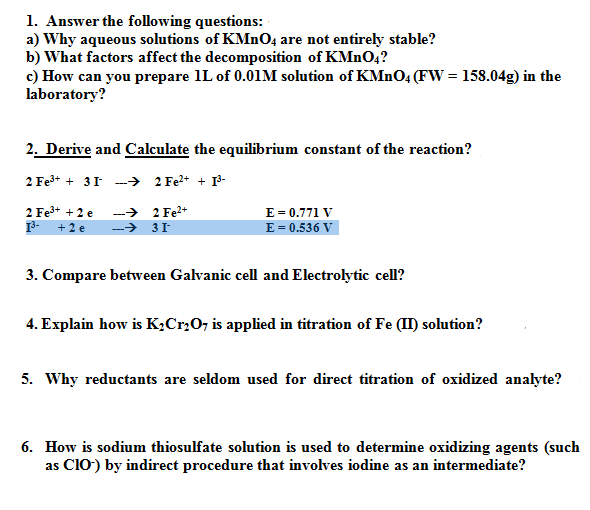1. Answer the following questions: a) Why aqueous solutions of KMN04 are not entirely stable? b) What factors affect the decomposition of KMNO4? c) How can you prepare 1L of 0.01M solution of KMnO4 (FW = 158.04g) in the laboratory? 2. Derive and Calculate the equilibrium constant of the reaction? 2 Fe3+ + 31 --→ 2 Fe2+ + I3- 2 Fe3+ + 2 e + 2 e 2 Fe+ 31 E= 0.771 V E = 0.536 V
1. Answer the following questions: a) Why aqueous solutions of KMN04 are not entirely stable? b) What factors affect the decomposition of KMNO4? c) How can you prepare 1L of 0.01M solution of KMnO4 (FW = 158.04g) in the laboratory? 2. Derive and Calculate the equilibrium constant of the reaction? 2 Fe3+ + 31 --→ 2 Fe2+ + I3- 2 Fe3+ + 2 e + 2 e 2 Fe+ 31 E= 0.771 V E = 0.536 V
Chemistry: Principles and Reactions
8th Edition
ISBN:9781305079373
Author:William L. Masterton, Cecile N. Hurley
Publisher:William L. Masterton, Cecile N. Hurley
Chapter12: Gaseous Chemical Equilibrium
Section: Chapter Questions
Problem 23QAP: Ammonium carbamate solid (NH4CO2NH2) decomposes at 313 K into ammonia and carbon dioxide gases. At...
Related questions
Question

Transcribed Image Text:1. Answer the following questions:
a) Why aqueous solutions of KMNO4 are not entirely stable?
b) What factors affect the decomposition of KMNO4?
c) How can you prepare 1L of 0.01M solution of KMnO4 (FW = 158.04g) in the
laboratory?
2. Derive and Calculate the equilibrium constant of the reaction?
2 Fe3+ + 31 -→ 2 Fe* + P-
2 Fe3+ + 2 e
-
+2 e
E = 0.771 V
E = 0.536 V
-> 2 Fe2+
->
3. Compare between Galvanic cell and Electrolytic cell?
4. Explain how is K¿Cr,07 is applied in titration of Fe (II) solution?
5. Why reductants are seldom used for direct titration of oxidized analyte?
6. How is sodium thiosulfate solution is used to determine oxidizing agents (such
as ClO) by indirect procedure that involves iodine as an intermediate?
Expert Solution
This question has been solved!
Explore an expertly crafted, step-by-step solution for a thorough understanding of key concepts.
Step by step
Solved in 2 steps

Knowledge Booster
Learn more about
Need a deep-dive on the concept behind this application? Look no further. Learn more about this topic, chemistry and related others by exploring similar questions and additional content below.Recommended textbooks for you

Chemistry: Principles and Reactions
Chemistry
ISBN:
9781305079373
Author:
William L. Masterton, Cecile N. Hurley
Publisher:
Cengage Learning

Principles of Instrumental Analysis
Chemistry
ISBN:
9781305577213
Author:
Douglas A. Skoog, F. James Holler, Stanley R. Crouch
Publisher:
Cengage Learning

Chemical Principles in the Laboratory
Chemistry
ISBN:
9781305264434
Author:
Emil Slowinski, Wayne C. Wolsey, Robert Rossi
Publisher:
Brooks Cole

Chemistry: Principles and Reactions
Chemistry
ISBN:
9781305079373
Author:
William L. Masterton, Cecile N. Hurley
Publisher:
Cengage Learning

Principles of Instrumental Analysis
Chemistry
ISBN:
9781305577213
Author:
Douglas A. Skoog, F. James Holler, Stanley R. Crouch
Publisher:
Cengage Learning

Chemical Principles in the Laboratory
Chemistry
ISBN:
9781305264434
Author:
Emil Slowinski, Wayne C. Wolsey, Robert Rossi
Publisher:
Brooks Cole

Chemistry for Engineering Students
Chemistry
ISBN:
9781337398909
Author:
Lawrence S. Brown, Tom Holme
Publisher:
Cengage Learning


Chemistry: An Atoms First Approach
Chemistry
ISBN:
9781305079243
Author:
Steven S. Zumdahl, Susan A. Zumdahl
Publisher:
Cengage Learning